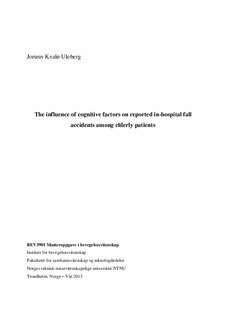| dc.description.abstract | Background: In-hospital falls among elderly represent a major problem for both the patient and the hospital. It can lead to serious physical injuries requiring surgery, prolonged rehabilitation, psychological trauma, fear of new falls, dependency in daily activities, and even death. In-hospital falls are one of the most common adverse events reported by hospitals both internationally and nationally. One of the most prominent risk factors for falls is cognitive impairment. The incidence of falls in older people with cognitive impairment is found to be twice as high as in cognitively intact people. The aim of the study was to map and describe the relations between cognitive impairment and fall related injuries, functional decline in terms of mobility level, assistance in ADL (Activities of Daily Living) and place of residence, and survival rate among elderly inpatients with a reported fall accident.
Methods: The project was conducted as a retrospective descriptive study, based on medical records of elderly patients, 75 years and older, all with an in-hospital fall accident reported as an adverse event in 2009. The patients were categorized in the following groups; Cognitive Intact (CI), Mild Cognitive Impairment (MCI) and Dementia.
Results: There were no significant differences between the groups of cognitively intact patients, patients with mild cognitive impairment and dement patients with respect to time of fall. Cognitive intact patients sustained both fewer injuries and fewer fractures after an in-hospital fall compared to patients with mild cognitive impairment and patients with dementia, but the results were not statistically significant. More demented patients admitted from their home were sent to a nursing home at discharge, compared to the other two groups (p=0.03). There was also a non-significant trend for cognitively impaired patients to have a larger decline in mobility level and increase in helping needs from hospital admission to discharge than for those being cognitively intact. No significant relation was found between cognitive impairment and one-year mortality, though the results found that more cognitively impaired patients died earlier after the in-hospital fall compared to cognitive intact patients.
Conclusion: Cognitive impaired patients’ have more reported in-hospital falls compared to cognitively intact patients, and they experience a larger functional decline during hospitalization. Overall elderly patients with reported in-hospital falls are a vulnerable and frail patient group which show poor outcomes after hospitalization in terms of high mortality and functional decline regardless of their cognitive state. Additional studies with more accuracy in the categorizing of cognitive state, using valid and reliable diagnostic methods are needed. | nb_NO |
